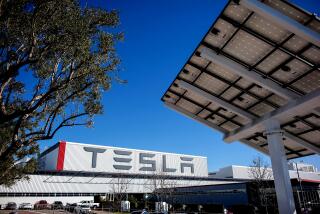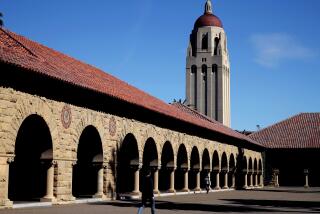Poor Man . . .
- Share via
Troubling evidence of a widening gulf between America’s rich and poor has triggered political firestorms from Washington to the smallest municipality. But a remarkable, if mostly unnoticed, immigrant and high-skill urban economic resurgence is taking place that could shrink the wage gap.
Immigrant upward mobility is critically important to income distribution because the initial flow of less-skilled people to urban centers can depress overall wages. Historically, however, even the poorest of immigrants are able to build on strong family ties to save money for and educate their children, most of whom achieve average U.S. household incomes in about three generations. In due course, wages and living standards rise for millions of people.
At the other extreme, America’s truly premier industries, and the high incomes they create, only develop where dense networks of specialized businesses thrive--Silicon Valley computer makers, Houston business-service firms, Seattle aerospace companies or Los Angeles entertainment companies. In a world where any one product or service can be copied and sold more cheaply by countless others, it is tightly integrated, complex, difficult-to-duplicate regional economies that foster high-end wages for large numbers of people. That’s why a high-school-educated Hollywood lighting technician can drive a German sports car and open her own production company, while Midwest computer scientists selling cookie-cutter programming services struggle in competition with India.
Income distribution improves when high-end industries--and those such as nondurable manufacturing that absorb ready-to-work, if initially untrained immigrants--vigorously expand. For years, this is how the nation grew, creating a mix of jobs that benefited the most and least skilled alike.
In the last decade, however, the United States took a perverse turn. As less-educated, less-skilled and less-diverse workers were reshuffled from immigrant-rich, high-wage urban economies to peripheral regions, a strange, new “hick” economy began to form. Driven in part by shortsighted urban elites that overregulated their local businesses and by beggar-thy-neighbor business-subsidy programs in the hinterlands, lower-wage, lower-skill regions stripped vital capital investment and entry-level jobs from the cities.
By 1994, virtually all high-end and immigrant economies--California, Seattle, Boston, New Jersey, Pennsylvania and the Northeast--were either growing slower than the national average or mired in recession. Low-wage, low-skill states like Arizona, Nevada, Georgia, Mississippi and Idaho--and cities like Las Vegas, Phoenix, Denver, Provo and Atlanta--boomed. The U.S. economy seemed to have permanently shifted in favor of regions built around the likes of back-office, coupon-clipping financial services, “screwdriver” assembly plants, gambling, food processing and telemarketing.
This decade-long development pattern helps explain why U.S. wages stagnated and income inequality grew. Shifting entry-level jobs from cities to such states as Idaho reduced immigrants’ opportunities to advance and capped wages for workers in the less-diversified hinterlands. Diverting capital to states like Georgia and encouraging once dense, globally competitive industrial networks to fragment severely dampened high-quality wage growth.
But while opportunistic hinterland leaders and anti-urban moralists chortled, immigrant-rich, high-wage urban economies suddenly made a remarkable, if totally unexpected comeback.
California, virtually given up for dead in the early 1990s, is now the nation’s top job producer, growing faster than all but 13 states. California, Texas and Florida today account for a whopping 30% of the country’s net employment growth, far more than their share of total U.S. population. Job growth in other high-wage and immigrant-rich states like New Jersey and Washington, all of which struggled earlier in the decade, is now as much as 170% above 1994 levels.
Even Los Angeles County, the nation’s unwitting symbol of urban dysfunction, now generates 90,000 jobs a year, more than all but eight states, including much larger Ohio, Illinois, New York, Michigan and New Jersey. More remarkable, metropolitan Los Angeles is growing faster than such widely celebrated regions as Denver and Raleigh-Durham, and more than twice as fast as Chicago, Knoxville, New York, Richmond, San Antonio and Baltimore. Impressive turnarounds are also occurring in high-skill, high-wage centers like Boston, Seattle, Philadelphia, Orange County and San Francisco.
As this astonishing industrial story unfolds, two kinds of regions are coming up short: monolithically governed urban giants, like greater New York City, and the states that comprise the very core of the once confident “hick” economy.
New York provides a stark contrast with the current vitality of other major immigrant, high-skill cities in California, Texas and Florida. It destroyed nondurable and related manufacturing industries, which provided jobs for work-hungry immigrants, under an onslaught of taxes, zoning and regulatory harassment. While a self-congratulatory white-collar elite thrived in Manhattan, a vast range of jobs, from entry to middle-class levels, evaporated from the rest of the city.
The result is an especially appalling example of the income disparity that offends most Americans. While Manhattan’s pampered elite toasts its prosperous veneer, New York’s metropolitan unemployment rate skyrocketed to just under 10% last month, far and away the worst performance of any major U.S. city. Immigrant groups have been decimated. The ratio of single-parent to married families, for example--the most important measure of immigrant economic and social health--is nearly 40% for New York Latinos, more than double the proportion in Los Angeles and Miami.
A wide swatch of the once-flourishing Midwest, South and intermountain West has also hit the economic skids. Annual job growth is now below 1.5% in Ohio, Illinois, South Carolina, Tennessee, Montana and Michigan, and fell by 20% to 40% in healthier Nevada, Arizona, Colorado and Georgia. Unemployment rates are rising in Phoenix and Atlanta but falling by more than 20% in Seattle, San Diego and San Francisco, and by 13%-18% in Boston and Los Angeles.
Unlike New York, the “hick” economy’s slowdown stems from rising costs--particularly troublesome to middle-tier, price-sensitive businesses it attracts--as its once-substantial housing and employment surpluses evaporate. Many “boom” communities are also struggling to serve their new residents after they gutted their local tax base to subsidize footloose companies, most of which threaten to move again if taxes or other expenses, like wages, should rise.
The United States may thus be changing in ways consistent with both greater wage equity and high-end network economic expansion. Yet, its leaders exhibit little understanding of this possibility.
One promising development, clearly evident in the L.A. mayoral elections, is the chance that a wide range of urban ethnic and social groups can unite to advance governance philosophies consistent with high- and entry-level economic growth. Much the same immigrant/urban growth coalition that reelected Richard J. Riordan also brought prosperity to ethnically diverse Texas after that state’s terrible recession. This nascent trend could help redirect urban politics in ways that exploit, rather than destroy, metropolitan competitive advantages.
Combined with the strong resurgence of the nation’s high-tech boutique communities like Boston and Seattle, America’s fledgling urban renaissance could signal a new era of higher-quality prosperity that is more just as well. For far too long, the country suffered second-rate job growth in the hinterlands and elitist expansion in a few Manhattanesque inner cities. Now, as an economic sea change sweeps America, we have a chance to do much better.
More to Read
Get the L.A. Times Politics newsletter
Deeply reported insights into legislation, politics and policy from Sacramento, Washington and beyond. In your inbox twice per week.
You may occasionally receive promotional content from the Los Angeles Times.










